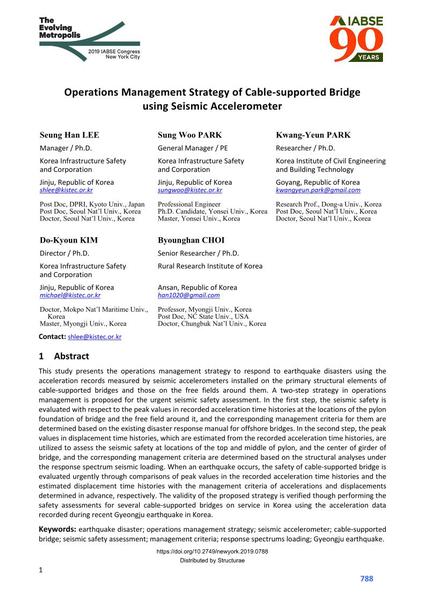Operations Management Strategy of Cable-supported Bridge using Seismic Accelerometer

|
|
|||||||||||
Détails bibliographiques
| Auteur(s): |
Seung Han Lee
(Korea Infrastructure Safety
and Corporation)
Sung Woo Park (Korea Infrastructure Safety and Corporation) Kwang-Yeun Park (Korea Institute of Civil Engineering and Building Technology) Do-Kyoun Kim (Korea Infrastructure Safety and Corporation) Byounghan Choi (Rural Research Institute of Korea) |
||||
|---|---|---|---|---|---|
| Médium: | papier de conférence | ||||
| Langue(s): | anglais | ||||
| Conférence: | IABSE Congress: The Evolving Metropolis, New York, NY, USA, 4-6 September 2019 | ||||
| Publié dans: | The Evolving Metropolis | ||||
|
|||||
| Page(s): | 788-793 | ||||
| Nombre total de pages (du PDF): | 6 | ||||
| DOI: | 10.2749/newyork.2019.0788 | ||||
| Abstrait: |
This study presents the operations management strategy to respond to earthquake disasters using the acceleration records measured by seismic accelerometers installed on the primary structural elements of cable-supported bridges and those on the free fields around them. A two-step strategy in operations management is proposed for the urgent seismic safety assessment. In the first step, the seismic safety is evaluated with respect to the peak values in recorded acceleration time histories at the locations of the pylon foundation of bridge and the free field around it, and the corresponding management criteria for them are determined based on the existing disaster response manual for offshore bridges. In the second step, the peak values in displacement time histories, which are estimated from the recorded acceleration time histories, are utilized to assess the seismic safety at locations of the top and middle of pylon, and the center of girder of bridge, and the corresponding management criteria are determined based on the structural analyses under the response spectrum seismic loading. When an earthquake occurs, the safety of cable-supported bridge is evaluated urgently through comparisons of peak values in the recorded acceleration time histories and the estimated displacement time histories with the management criteria of accelerations and displacements determined in advance, respectively. The validity of the proposed strategy is verified though performing the safety assessments for several cable-supported bridges on service in Korea using the acceleration data recorded during recent Gyeongju earthquake in Korea. |
||||
